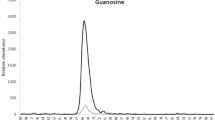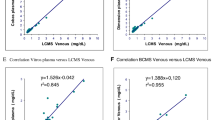Abstract
Although dried blood spot (DBS) sampling is increasingly receiving interest as a potential alternative to traditional blood sampling, the impact of hematocrit (Hct) on DBS results is limiting its final breakthrough in routine bioanalysis. To predict the Hct of a given DBS, potassium (K+) proved to be a reliable marker. The aim of this study was to evaluate whether application of an algorithm, based upon predicted Hct or K+ concentrations as such, allowed correction for the Hct bias. Using validated LC-MS/MS methods, caffeine, chosen as a model compound, was determined in whole blood and corresponding DBS samples with a broad Hct range (0.18–0.47). A reference subset (n = 50) was used to generate an algorithm based on K+ concentrations in DBS. Application of the developed algorithm on an independent test set (n = 50) alleviated the assay bias, especially at lower Hct values. Before correction, differences between DBS and whole blood concentrations ranged from −29.1 to 21.1 %. The mean difference, as obtained by Bland-Altman comparison, was −6.6 % (95 % confidence interval (CI), −9.7 to −3.4 %). After application of the algorithm, differences between corrected and whole blood concentrations lay between −19.9 and 13.9 % with a mean difference of −2.1 % (95 % CI, −4.5 to 0.3 %). The same algorithm was applied to a separate compound, paraxanthine, which was determined in 103 samples (Hct range, 0.17–0.47), yielding similar results. In conclusion, a K+-based algorithm allows correction for the Hct bias in the quantitative analysis of caffeine and its metabolite paraxanthine.

Percentage differences between uncorrected DBS and whole blood paraxanthine concentrations (upper panel) and between corrected and whole blood paraxanthine concentrations (lower panel) (n = 103)




Similar content being viewed by others
References
Stove CP, Ingels AS, De Kesel PM, Lambert WE (2012) Dried blood spots in toxicology: from the cradle to the grave? Crit Rev Toxicol 42:230–243
Meesters RJW, Hooff GP (2013) State-of-the-art dried blood spot analysis: an overview of recent advances and future trends. Bioanalysis 5:2187–2208
De Kesel PM, Sadones N, Capiau S, Lambert WE, Stove CP (2013) Hemato-critical issues in quantitative analysis of dried blood spots: challenges and solutions. Bioanalysis 5:2023–2041
Denniff P, Spooner N (2010) The effect of hematocrit on assay bias when using DBS samples for the quantitative bioanalysis of drugs. Bioanalysis 2:1385–1395
Rowland M, Emmons GT (2010) Use of dried blood spots in drug development: pharmacokinetic considerations. AAPS Journal 12:290–293
De Kesel PM, Capiau S, Lambert WE, Stove CP (2014) Current strategies to cope with the hematocrit problem in dried blood spots analysis. Bioanalysis. doi:10.4155/BIO.14.151
Capiau S, Stove VV, Lambert WE, Stove CP (2013) Prediction of the hematocrit of dried blood spots via potassium measurement on a routine clinical chemistry analyzer. Anal Chem 85:404–410
De Kesel PM, Lambert WE, Stove CP (2014) Why dried blood spots are an ideal tool for CYP1A2 phenotyping. Clin Pharmacokinet 53:763–771
De Kesel PM, Lambert WE, Stove CP (2014) CYP1A2 phenotyping in dried blood spots and microvolumes of whole blood and plasma. Bioanalysis. doi:10.4155/BIO.14.149
Acknowledgments
The authors wish to acknowledge all volunteers who participated in the study and the skillful staff of the 24-h lab from Ghent University Hospital. S. Capiau wishes to acknowledge the FWO Research Foundation Flanders for granting her a PhD Fellowship. This study was financed by the Laboratory of Toxicology, Ghent University, Belgium.
Conflict of interest
The authors have no conflict of interest to declare. The authors received no additional funding directly related to the content of this study.
Author information
Authors and Affiliations
Corresponding author
Rights and permissions
About this article
Cite this article
De Kesel, P.M.M., Capiau, S., Stove, V.V. et al. Potassium-based algorithm allows correction for the hematocrit bias in quantitative analysis of caffeine and its major metabolite in dried blood spots. Anal Bioanal Chem 406, 6749–6755 (2014). https://doi.org/10.1007/s00216-014-8114-z
Received:
Revised:
Accepted:
Published:
Issue Date:
DOI: https://doi.org/10.1007/s00216-014-8114-z




